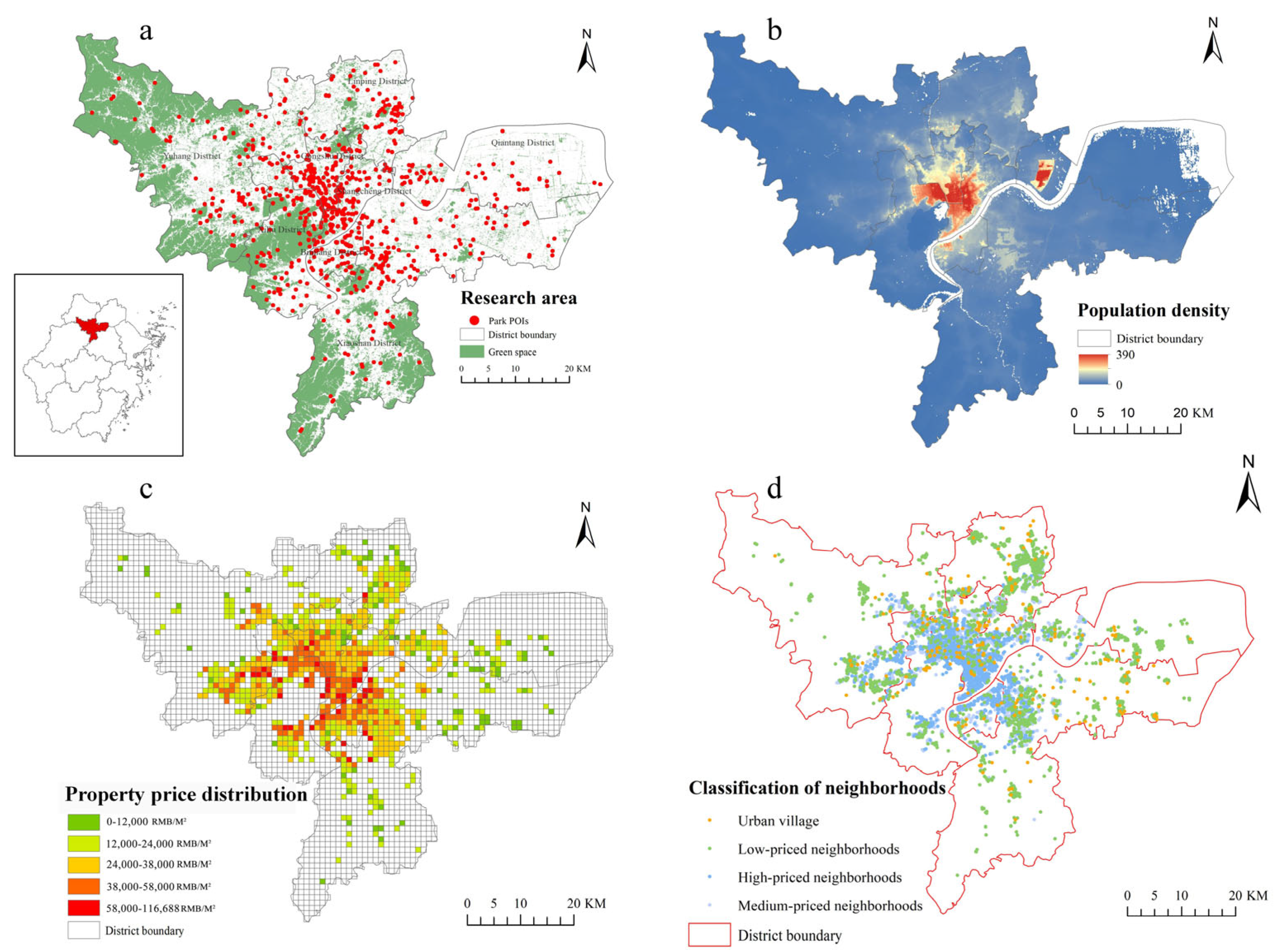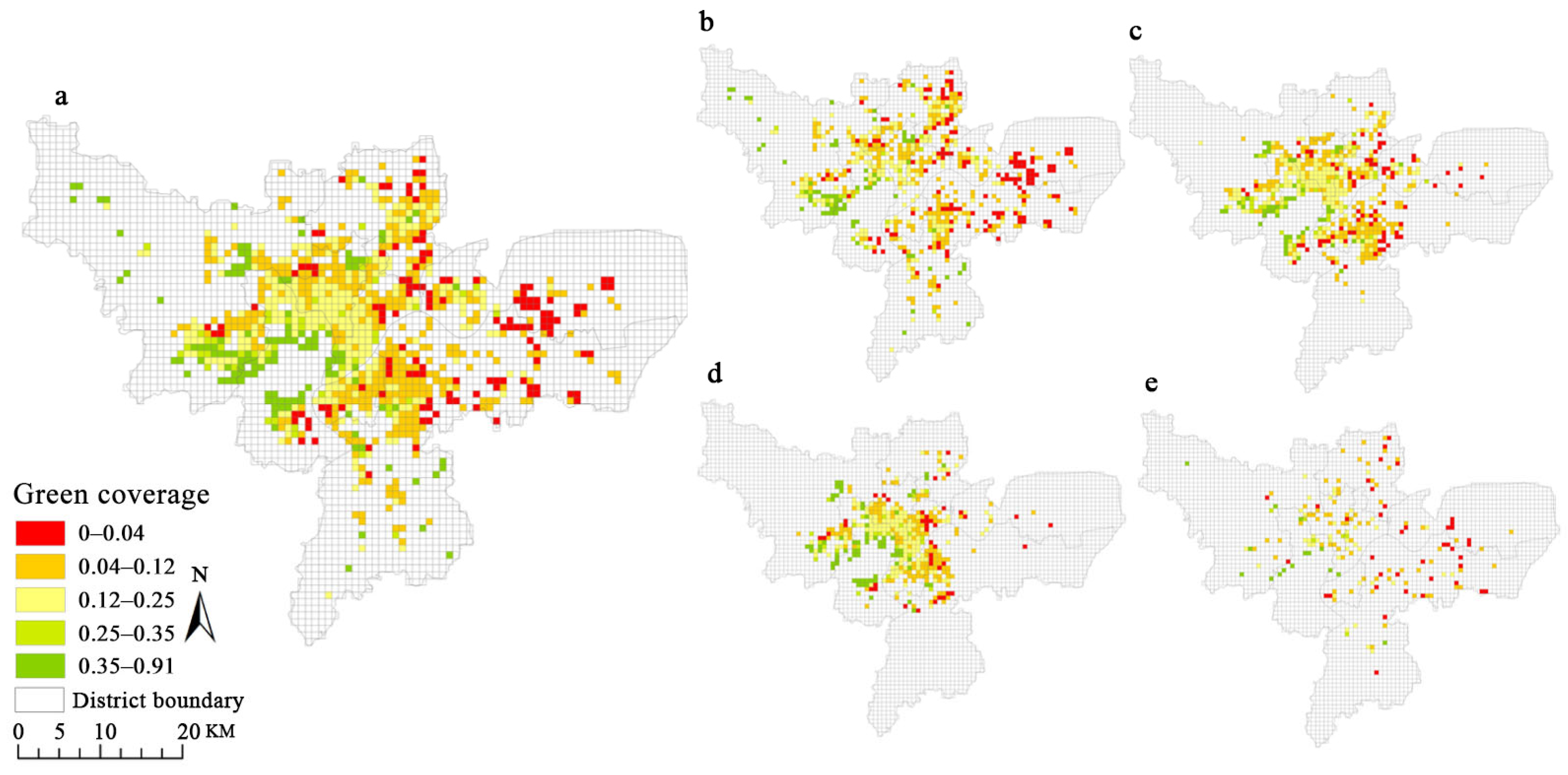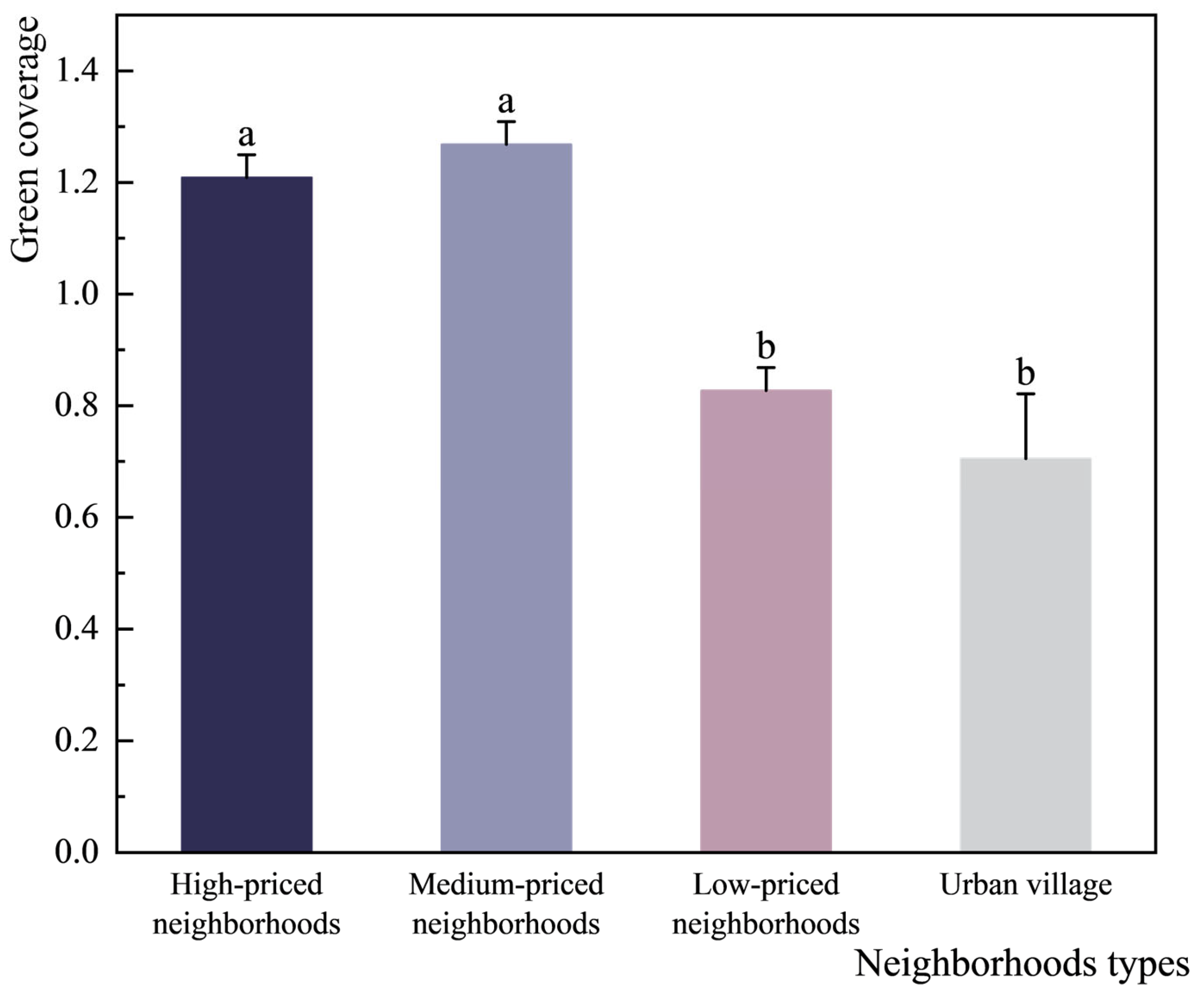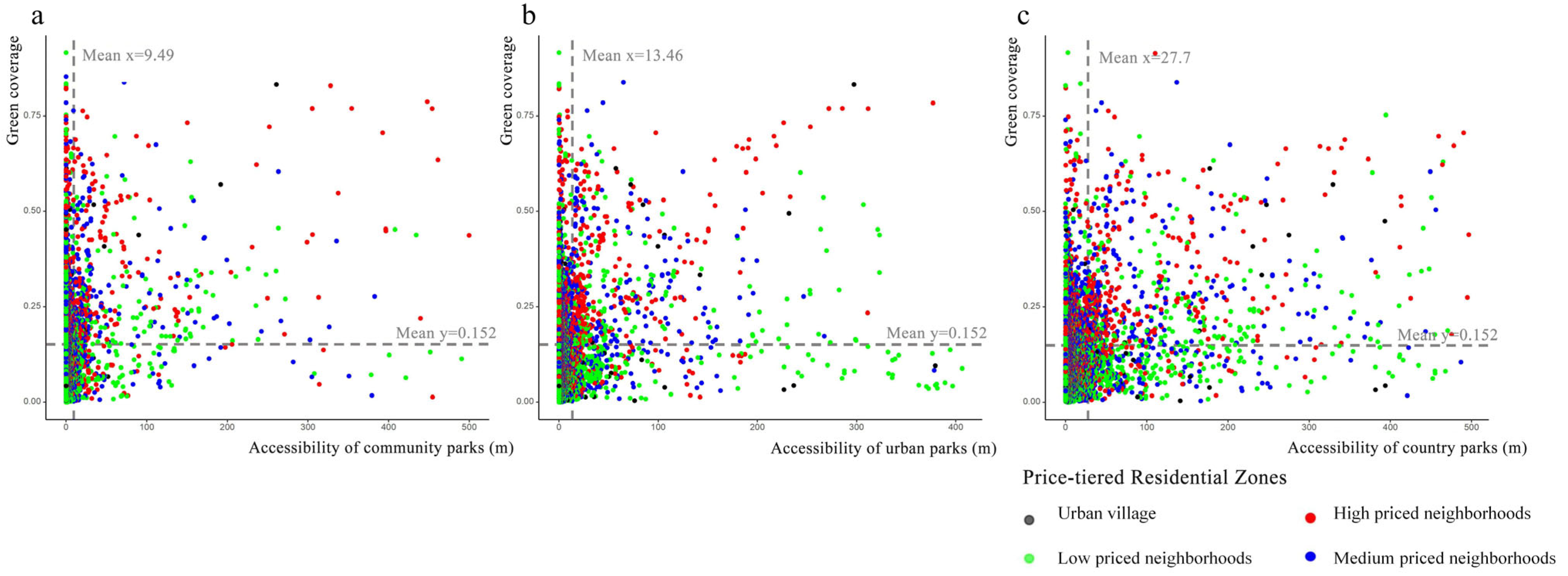Is Green Space More Equitable in High-Income Areas? A Case Study of Hangzhou, China
Abstract
1. Introduction
2. Materials and Methods
2.1. Study Area
2.2. Data Collection
2.2.1. Green Space Data
2.2.2. Property Price
2.2.3. Urban Population
2.2.4. Urban Road Network
2.3. Data Analysis
2.3.1. Green Coverage
2.3.2. Park Accessibility
2.3.3. Equity Measurement
3. Results
3.1. Spatial Patterns of Green Coverage and Accessibility
3.2. Relationship Among Property Prices, Green Coverage, and Park Accessibility
3.3. Relationship Between Property Prices and Urban Green Space Equity
4. Discussion
4.1. Differences in Equity Between Green Coverage and Park Accessibility
4.2. Variation in Green Space Equity Across Different Park Types
4.3. Urban Green Space Equity Is Not Equal to Sufficient Supply
4.4. Policy Implications
- (1)
- Insert greenery into available spatial gaps in the urban region. To address the mismatch between total GC and park accessibility, additional greening facilities should be installed in low-green coverage neighborhoods. Local special urban green space planning, integrated with urban renewal strategy, should focus on building pocket or community parks around old residential areas. It also aims to create a green web system by developing linear parks that combine waterways and road greenery. Small and decentralized urban green spaces are encouraged in the vulnerable-group aggregation areas, while large and centralized parks should be located in suburban districts, allowing more people to enjoy both the visual and tactile benefits of urban green spaces.
- (2)
- Increase three-dimensional greening. We suggest enhancing supervision and guidance of different ancillary green spaces and advancing the three-dimensional greening. Low-priced neighborhoods and urban villages generally have limited access to the benefits of park services. These areas often have high building densities; therefore, measures that account for urban structures should be considered, including wall greening and rooftop gardens. Such measures can increase greening within and around neighborhoods and enhance the ecological services of green infrastructure. Inaccessible pocket parks can also be opened up with more entrances, while fragmented vegetated areas can be connected to increase the total amount of accessible green space. In regions with low park accessibility, road network services should be upgraded in addition to building new parks and improving low-quality urban green spaces.
- (3)
- Enhance the efficiency of park utilization. High-priced neighborhoods typically have abundant urban green space resources, but utilization efficiency varies widely. For neighborhoods with high GC but low accessibility, creating more entrances and providing parts of the interior green space to share with the surrounding community will increase the utilization of green resources. Community parks are most frequently visited by residents. Therefore, adjusting existing urban green space planning to build more small-scale greening facilities (e.g., greenways or pocket parks) can further improve accessibility and enhance the quality of urban settlements.
4.5. Limitations
- (1)
- The calculation of park accessibility using G2SFCA simulated access time based on the network analysis module. However, this method did not consider differences in traffic conditions between the city center and the outskirts, or other factors that affect actual access costs. In the future, accuracy could be improved by combining path-planning techniques with transportation internet of things information.
- (2)
- The scope of this study only covered economically developed cities. Therefore, the policy implications are also place-based, and can be applied to these developed cities in East China. Urban green space equity varies in cities with different physical, social, and cultural contexts. Future research could expand this analysis to developing cities and incorporate multi-source data such as remote sensing data, statistical yearbooks, and other sources for cross-regional comparisons.
- (3)
- This study measured green space quantity without considering its quality. Future studies could include indicators of park green space quality, such as NDVI and biodiversity, in their analyses.
5. Conclusions
Author Contributions
Funding
Data Availability Statement
Acknowledgments
Conflicts of Interest
References
- United Nations Human Settlements Programme. World Cities Report 2022: Envisaging the Future of Cities. Nairobi: United Nations Human Settlements Programme. 2022. Available online: https://unhabitat.org/wcr/ (accessed on 2 November 2024).
- Aguilar, A.G.; Hernandez-Lozano, J. Mega-Urbanization, Territorial Fragmentation and Social Inequality in the Global South: The Case of Mexico City and Its City-Region. Appl. Geogr. 2024, 163, 103183. [Google Scholar] [CrossRef]
- Racial Disparities in Pollution Exposure and Employment at US Industrial Facilities | PNAS. Available online: https://www.pnas.org/doi/full/10.1073/pnas.1721640115 (accessed on 4 November 2024).
- Yan, L.; Jia, W.; Zhao, S. The Cooling Effect of Urban Green Spaces in Metacities: A Case Study of Beijing, China’s Capital. Remote Sens. 2021, 13, 4601. [Google Scholar] [CrossRef]
- Teixeira, C.P.; Fernandes, C.O.; Ryan, R.; Ahern, J. Attitudes and Preferences towards Plants in Urban Green Spaces: Implications for the Design and Management of Novel Urban Ecosystems. J. Environ. Manag. 2022, 314, 115103. [Google Scholar] [CrossRef] [PubMed]
- Salvatore, M.A.; Grundy, E. Area Deprivation, Perceived Neighbourhood Cohesion and Mental Health at Older Ages: A Cross Lagged Analysis of UK Lon-gitudinal Data. Health Place 2021, 67, 102470. [Google Scholar] [CrossRef]
- Dean, A.J.; Ross, H.; Roiko, A.; Fielding, K.S.; Saeck, E.; Johnston, K.; Beatson, A.; Udy, J.; Maxwell, P. Beyond Proximity: How Subjective Perceptions of Enablers and Constraints Influence Patterns of Blue Space Recreation. Landsc. Urban Plan. 2022, 228, 104557. [Google Scholar] [CrossRef]
- Tian, D.; Wang, J.; Xia, C.; Zhang, J.; Zhou, J.; Tian, Z.; Zhao, J.; Li, B.; Zhou, C. The Relationship between Green Space Accessibility by Multiple Travel Modes and Housing Prices: A Case Study of Beijing. Cities 2024, 145, 104694. [Google Scholar] [CrossRef]
- Dickinson, D.C.; Hobbs, R.J. Cultural Ecosystem Services: Characteristics, Challenges and Lessons for Urban Green Space Research. Ecosyst. Serv. 2017, 25, 179–194. [Google Scholar] [CrossRef]
- Diener, A.; Mudu, P. How Can Vegetation Protect Us from Air Pollution? A Critical Review on Green Spaces’ Mitigation Abilities for Air-Borne Par-ticles from a Public Health Perspective—With Implications for Urban Planning. Sci. Total Environ. 2021, 796, 148605. [Google Scholar] [CrossRef]
- Bressane, A.; Loureiro, A.I.S.; Negri, R.G. Environmental Racism in the Accessibility of Urban Green Space: A Case Study of a Metropolitan Area in an Emerging Economy. Urban Sci. 2024, 8, 224. [Google Scholar] [CrossRef]
- Sun, Y.; Saha, S.; Tost, H.; Kong, X.; Xu, C. Literature Review Reveals a Global Access Inequity to Urban Green Spaces. Sustainability 2022, 14, 1062. [Google Scholar] [CrossRef]
- Bressane, A.; Cunha Pinto, J.P.D.; Castro Medeiros, L.C.D. Urban Green Space Disparities: Implications of Environmental Injustice for Public Health. Urban For. Urban Green. 2024, 99, 128441. [Google Scholar] [CrossRef]
- Kronenberg, J.; Haase, A.; Łaszkiewicz, E.; Antal, A.; Baravikova, A.; Biernacka, M.; Dushkova, D.; Filčak, R.; Haase, D.; Ignatieva, M.; et al. Environmental Justice in the Context of Urban Green Space Availability, Accessibility, and Attractiveness in Postsocialist Cities. Cities 2020, 106, 102862. [Google Scholar] [CrossRef]
- Zhang, J.; Xu, E. Investigating the Spatial Distribution of Urban Parks from the Perspective of Equity-Efficiency: Evidence from Chengdu, China. Urban For. Urban Green. 2023, 86, 128019. [Google Scholar] [CrossRef]
- Gu, X.; Tao, S.; Dai, B. Spatial Accessibility of Country Parks in Shanghai, China. Urban For. Urban Green. 2017, 27, 373–382. [Google Scholar] [CrossRef]
- Gu, X.; Li, Q.; Chand, S. Factors Influencing Residents’ Access to and Use of Country Parks in Shanghai, China. Cities 2020, 97, 102501. [Google Scholar] [CrossRef]
- Nesbitt, L.; Meitner, M.J.; Girling, C.; Sheppard, S.R.J.; Lu, Y. Who Has Access to Urban Vegetation? A Spatial Analysis of Distributional Green Equity in 10 US Cities. Landsc. Urban Plan. 2019, 181, 51–79. [Google Scholar] [CrossRef]
- Deng, Z.; Ning, L. Inequity in Accessibility to Urban Parks in Environmental Gentrification Areas Based on Multi-G3SFCA: A Case Study of Wu-han’s Main Urban Districts. Ecol. Indic. 2024, 169, 112899. [Google Scholar] [CrossRef]
- Grove, J.M.; Locke, D.H.; O’Neil-Dunne, J.P.M. An Ecology of Prestige in New York City: Examining the Relationships Among Population Density, Socio-Economic Status, Group Identity, and Residential Canopy Cover. Environ. Manag. 2014, 54, 402–419. [Google Scholar] [CrossRef]
- Chen, S.; Knöll, M. Environmental Justice in the Context of Access to Urban Green Spaces for Refugee Children. Land 2024, 13, 716. [Google Scholar] [CrossRef]
- Larson, E.K.; Perrings, C. The Value of Water-Related Amenities in an Arid City: The Case of the Phoenix Metropolitan Area. Landsc. Urban Plan. 2013, 109, 45–55. [Google Scholar] [CrossRef]
- Bressane, A.; Pinto, J.P.D.C.; Medeiros, L.C.D.C. Countering the Effects of Urban Green Gentrification through Nature-Based Solutions: A Scoping Review. Nat.-Based Solut. 2024, 5, 100131. [Google Scholar] [CrossRef]
- Anguelovski, I.; Connolly, J.J.T.; Masip, L.; Pearsall, H. Assessing Green Gentrification in Historically Disenfranchised Neighborhoods: A Longitudinal and Spatial Analysis of Barce-lona. Urban Geogr. 2018, 39, 458–491. [Google Scholar] [CrossRef]
- Rigolon, A.; Yañez, E.; Aboelata, M.J.; Bennett, R. “A Park Is Not Just a Park”: Toward Counter-Narratives to Advance Equitable Green Space Policy in the United States. Cities 2022, 128, 103792. [Google Scholar] [CrossRef]
- Wolch, J.R.; Byrne, J.; Newell, J.P. Urban Green Space, Public Health, and Environmental Justice: The Challenge of Making Cities ‘Just Green Enough’. Landsc. Urban Plan. 2014, 125, 234–244. [Google Scholar] [CrossRef]
- Shang, L.; Zhang, X.; Tang, D.; Ma, X.; Lu, C. The Impact of Housing Support Expenditure on Urban Residents’ Consumption—Evidence from China. Sustainability 2023, 15, 9223. [Google Scholar] [CrossRef]
- Dong, Q.; Lu, H.; Luo, X.; He, P.; Li, D.; Wu, L.; Wei, Y.; Chen, X. Evaluation and Optimization of Green Space Fairness in Urban Built-Up Areas Based on an Improved Supply and Demand Model: A Case Study of Chengdu, China. Sustainability 2023, 15, 15014. [Google Scholar] [CrossRef]
- Chen, S.; Zhang, L.; Huang, Y.; Wilson, B.; Mosey, G.; Deal, B. Spatial Impacts of Multimodal Accessibility to Green Spaces on Housing Price in Cook County, Illinois. Urban For. Urban Green. 2022, 67, 127370. [Google Scholar] [CrossRef]
- Xia, N.; Cheng, L.; Chen, S.; Wei, X.; Zong, W.; Li, M. Accessibility Based on Gravity-Radiation Model and Google Maps API: A Case Study in Australia. J. Transp. Geogr. 2018, 72, 178–190. [Google Scholar] [CrossRef]
- Comber, A.; Brunsdon, C.; Green, E. Using a GIS-Based Network Analysis to Determine Urban Greenspace Accessibility for Different Ethnic and Religious Groups. Landsc. Urban Plan. 2008, 86, 103–114. [Google Scholar] [CrossRef]
- Zhang, Y.; Luo, F.; Dai, Y.; Zhang, C. Changing Spatial Inclusion of Migrants in Chinese Cities: How Housing Matters. Habitat Int. 2025, 157, 103319. [Google Scholar] [CrossRef]
- Rigolon, A.; Browning, M.; Jennings, V. Inequities in the Quality of Urban Park Systems: An Environmental Justice Investigation of Cities in the United States. Landsc. Urban Plan. 2018, 178, 156–169. [Google Scholar] [CrossRef]
- GB50180—2018; Urban Residential Area Planning and Design Standard. Ministry of Housing and Urban-Rural Development; China Architecture & Building Press: Beijing, China, 2018.
- GB/T 51346—2019; Urban Green Space Planning Standard. Ministry of Housing and Urban-Rural Development; China Architecture & Building Press: Beijing, China, 2019.
- Chang, J.; Qu, Z.; Xu, R.; Pan, K.; Xu, B.; Min, Y.; Ren, Y.; Yang, G.; Ge, Y. Assessing the Ecosystem Services Provided by Urban Green Spaces along Urban Center-Edge Gradients. Sci. Rep. 2017, 7, 11226. [Google Scholar] [CrossRef] [PubMed]
- Díaz, S.; Pascual, U.; Stenseke, M.; Martín-López, B.; Watson, R.T.; Molnár, Z.; Hill, R.; Chan, K.M.A.; Baste, I.A.; Brauman, K.A.; et al. Assessing Nature’s Contributions to People. Science 2018, 359, 270–272. [Google Scholar] [CrossRef] [PubMed]
- Liu, S.; Zhang, X.; Feng, Y.; Xie, H.; Jiang, L.; Lei, Z. Spatiotemporal Dynamics of Urban Green Space Influenced by Rapid Urbanization and Land Use Policies in Shanghai. Forests 2021, 12, 476. [Google Scholar] [CrossRef]
- Dai, D. Black Residential Segregation, Disparities in Spatial Access to Health Care Facilities, and Late-Stage Breast Cancer Diagnosis in Metropolitan Detroit. Health Place 2010, 16, 1038–1052. [Google Scholar] [CrossRef]
- Martin, A.J.F.; Conway, T.M. Using the Gini Index to Quantify Urban Green Inequality: A Systematic Review and Recommended Reporting Standards. Landsc. Urban Plan. 2025, 254, 105231. [Google Scholar] [CrossRef]
- Chen, Y.; Ge, Y.; Yang, G.; Wu, Z.; Du, Y.; Mao, F.; Chang, J. Inequalities of Urban Green Space Area and Ecosystem Services along Urban Center-Edge Gradients. Landsc. Urban Plan. 2022, 217, 104266. [Google Scholar] [CrossRef]
- Wu, L.; Kim, S.K.; Lin, C. Socioeconomic Groups and Their Green Spaces Availability in Urban Areas of China: A Distributional Justice Perspective. Environ. Sci. Policy 2022, 131, 26–35. [Google Scholar] [CrossRef]
- Lee, J.-W.; Lee, S.-W.; Kim, H.G.; Jo, H.-K.; Park, S.-R. Green Space and Apartment Prices: Exploring the Effects of the Green Space Ratio and Visual Greenery. Land 2023, 12, 2069. [Google Scholar] [CrossRef]
- Gu, W.; Tang, Z.; Chen, Y.; Dai, M. Research on the Greening Rate and Spatial Differences of Urban Residential Neighborhoods in Shenzhen. Landsc. Archit. Front. 2021, 9, 60. [Google Scholar] [CrossRef]
- Chen, K.; Lin, H.; You, S.; Han, Y. Review of the Impact of Urban Parks and Green Spaces on Residence Prices in the Environmental Health Context. Front. Public Health 2022, 10, 993801. [Google Scholar] [CrossRef] [PubMed]
- Guo, Y.; Lei, G.; Zhang, L. Quality Evaluation of Park Green Space Based on Multi-Source Spatial Data in Shenyang. Sustainability 2023, 15, 8991. [Google Scholar] [CrossRef]
- Wu, J.; He, Q.; Chen, Y.; Lin, J.; Wang, S. Dismantling the Fence for Social Justice? Evidence Based on the Inequity of Urban Green Space Accessibility in the Central Ur-ban Area of Beijing. Environ. Plan. B Urban Anal. City Sci. 2020, 47, 626–644. [Google Scholar] [CrossRef]
- Shan, L.; He, S. The Role of Peri-Urban Parks in Enhancing Urban Green Spaces Accessibility in High-Density Contexts: An Environmental Jus-tice Perspective. Landsc. Urban Plan. 2025, 254, 105244. [Google Scholar] [CrossRef]
- Chen, B.; Wu, S.; Song, Y.; Webster, C.; Xu, B.; Gong, P. Contrasting Inequality in Human Exposure to Greenspace between Cities of Global North and Global South. Nat. Commun. 2022, 13, 4636. [Google Scholar] [CrossRef]
- Yuan, F.; Wei, Y.D.; Wu, J. Amenity Effects of Urban Facilities on Housing Prices in China: Accessibility, Scarcity, and Urban Spaces. Cities 2020, 96, 102433. [Google Scholar] [CrossRef]
- Wu, L.; Rowe, P.G. Green Space Progress or Paradox: Identifying Green Space Associated Gentrification in Beijing. Landsc. Urban Plan. 2022, 219, 104321. [Google Scholar] [CrossRef]
- Pearsall, H.; Eller, J.K. Locating the Green Space Paradox: A Study of Gentrification and Public Green Space Accessibility in Philadelphia, Pennsylva-nia. Landsc. Urban Plan. 2020, 195, 103708. [Google Scholar] [CrossRef]
- Richards, D.R.; Passy, P.; Oh, R.R.Y. Impacts of Population Density and Wealth on the Quantity and Structure of Urban Green Space in Tropical Southeast Asia. Landsc. Urban Plan. 2017, 157, 553–560. [Google Scholar] [CrossRef]







| Park Type | Area Range (ha) | Number | Proportion of Total Number (%) | Total Area (km2) | Proportion of Total Area (%) |
|---|---|---|---|---|---|
| Community | ≤10 | 721 | 81.1 | 12.3 | 2.5 |
| Urban | 10–20 | 92 | 10.3 | 7.6 | 1.5 |
| Country | >20 | 76 | 8.6 | 470.7 | 96 |
| Neighborhood Type | Number | Greening | Social Group | Population Density |
|---|---|---|---|---|
| High-priced neighborhoods | 1879 | Luxury gardens and pools | Rich class | Low |
| Medium-priced neighborhoods | 2040 | General greening | Middle class | Medium |
| Low-priced neighborhoods | 1981 | Scattered vegetation | Career starters | High |
| Urban villages | 216 | None | Students, migrant laborers | Overcrowded |
| Urban Green Spaces | SS | DF | MSS | R2 | F | p |
|---|---|---|---|---|---|---|
| Community park accessibility | 7.59 | 3 | 2.53 | 0.01 | 2.53 | 0.057 |
| Urban park accessibility | 9.83 | 3 | 3.28 | 0.02 | 0.85 | 0.001 |
| Country park accessibility | 1.46 × 106 | 3 | 4.87 × 106 | 0.01 | 8.63 | <0.001 |
| Green coverage | 79.86 | 3 | 26.62 | 0.04 | 26.64 | <0.001 |
| Urban Green Spaces | High-Priced Neighborhoods | Medium-Priced Neighborhoods | Low-Priced Neighborhoods | Urban Villages | Overall |
|---|---|---|---|---|---|
| Community park accessibility | 0.98 | 0.95 | 0.94 | 0.92 | 0.94 |
| Urban park accessibility | 0.95 | 0.88 | 0.91 | 0.85 | 0.90 |
| Country park accessibility | 0.92 | 0.94 | 0.95 | 0.98 | 0.93 |
| Green coverage | 0.82 | 0.61 | 0.60 | 0.67 | 0.66 |
Disclaimer/Publisher’s Note: The statements, opinions and data contained in all publications are solely those of the individual author(s) and contributor(s) and not of MDPI and/or the editor(s). MDPI and/or the editor(s) disclaim responsibility for any injury to people or property resulting from any ideas, methods, instructions or products referred to in the content. |
© 2025 by the authors. Licensee MDPI, Basel, Switzerland. This article is an open access article distributed under the terms and conditions of the Creative Commons Attribution (CC BY) license (https://creativecommons.org/licenses/by/4.0/).
Share and Cite
Du, S.; Sun, Y.; Yang, H.; Liu, M.; Tang, J.; Hu, G.; Tian, Y. Is Green Space More Equitable in High-Income Areas? A Case Study of Hangzhou, China. Land 2025, 14, 1183. https://doi.org/10.3390/land14061183
Du S, Sun Y, Yang H, Liu M, Tang J, Hu G, Tian Y. Is Green Space More Equitable in High-Income Areas? A Case Study of Hangzhou, China. Land. 2025; 14(6):1183. https://doi.org/10.3390/land14061183
Chicago/Turabian StyleDu, Shuqi, Yangyang Sun, Hao Yang, Miaoyan Liu, Jianuan Tang, Guang Hu, and Yuan Tian. 2025. "Is Green Space More Equitable in High-Income Areas? A Case Study of Hangzhou, China" Land 14, no. 6: 1183. https://doi.org/10.3390/land14061183
APA StyleDu, S., Sun, Y., Yang, H., Liu, M., Tang, J., Hu, G., & Tian, Y. (2025). Is Green Space More Equitable in High-Income Areas? A Case Study of Hangzhou, China. Land, 14(6), 1183. https://doi.org/10.3390/land14061183






